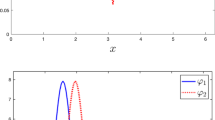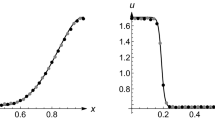Abstract
We study a renormalization transformation arising in an infinite system of interacting diffusions. The components of the system are labeled by the N-dimensional hierarchical lattice (N≥2) and take values in the closure of a compact convex set \(\bar D \subset \mathbb{R}^d (d \geqslant 1)\). Each component starts at some θ ∈ D and is subject to two motions: (1) an isotropic diffusion according to a local diffusion rate g: \(\bar D \to [0,\infty ]\) chosen from an appropriate class; (2) a linear drift toward an average of the surrounding components weighted according to their hierarchical distance. In the local mean-field limit N→∞, block averages of diffusions within a hierarchical distance k, on an appropriate time scale, are expected to perform a diffusion with local diffusion rate F (k) g, where \(F^{(k)} g = (F_{c_k } \circ ... \circ F_{c_1 } )\) g is the kth iterate of renormalization transformations F c (c>0) applied to g. Here the c k measure the strength of the interaction at hierarchical distance k. We identify F c and study its orbit (F (k) g) k≥0. We show that there exists a “fixed shape” g* such that lim k→∞ σk F (k) g = g* for all g, where the σ k are normalizing constants. In terms of the infinite system, this property means that there is complete universal behavior on large space-time scales. Our results extend earlier work for d = 1 and \(\bar D = [0,1]\), resp. [0, ∞). The renormalization transformation F c is defined in terms of the ergodic measure of a d-dimensional diffusion. In d = 1 this diffusion allows a Yamada–Watanabe-type coupling, its ergodic measure is reversible, and the renormalization transformation F c is given by an explicit formula. All this breaks down in d≥2, which complicates the analysis considerably and forces us to new methods. Part of our results depend on a certain martingale problem being well-posed.
Similar content being viewed by others
REFERENCES
J.-B. Baillon, Ph. Clément, A. Greven, and F. den Hollander, On the attracting orbit of a non-linear transformation arising from renormalization of hierarchically interacting diffusions. Part I: The compact case, Can. J. Math. 47:3–27 (1995).
J.-B. Baillon, Ph. Clément, A. Greven, and F. den Hollander, On the attracting orbit of a non-linear transformation arising from renormalization of hierarchically interacting diffusions. Part II: The non-compact case, J. Funct. Anal. 146–I:236–298 (1997).
J. T. Cox and A. Greven, Ergodic theorems for infinite systems of locally interacting diffusions, Ann. Probab. 22–II:833–853 (1994).
E. B. Dynkin, Markov Processes, Die Grundlehren der mathematischen Wissenschaften (Springer, Berlin, 1965).
D. A. Dawson and A. Greven, Multiple time scale analysis of hierarchically interacting systems, in Stochastic Processes, A Festschrift in Honour of Gopinath Kallianpur, S. Cambanis, J. K. Ghosh, R. L. Karandikar, and P. K. Sen, eds. (Springer, New York, 1993), pp. 41–50.
D. A. Dawson and A. Greven, Multiple time scale analysis of interacting diffusions, Probab. Theory Relat. Fields 95:467–508 (1993).
D. A. Dawson and A. Greven, Hierarchical models of interacting diffusions: Multiple time scale phenomena, phase transition and pattern of cluster-formation, Probab. Theory Relat. Fields 96:435–473 (1993).
D. A. Dawson and A. Greven, Multiple space-time scale analysis for interacting branching models, Electronic J. of Prob. 1 (1996), paper no. 14, pp. 1–84 (http://math.washington.edu/~ejpecp/).
D. A. Dawson, A. Greven, and J. Vaillancourt, Equilibria and quasi-equilibria for infinite collections of interacting Fleming-Viot processes, Trans. Am. Math. Soc. 347–VII:2277–2360 (1995).
D. A. Dawson and P. March, Resolvent estimates for Fleming-Viot operators and uniqueness of solutions to related martingale problems, J. Funct. Anal. 132–II:417–472 (1995).
S. N. Ethier and T. G. Kurtz, Markov Processes: Characterization and Convergence (John Wiley & Sons, New York, 1986).
A. Friedman, Partial Differential Equations of Parabolic Type (Prentice-Hall, Englewood Cliffs, 1964).
A. Klenke, Different clustering regimes in systems of hierarchically interacting diffusions, Ann. Probab. 24–II:660–697 (1996).
I. Karatzas and S. E. Shreve, Brownian Motion and Stochastic Calculus, second edition (Springer, New York, 1991).
M. H. Protter and H. F. Weinberger, Maximum Principles in Differential Equations (Prentice-Hall, Englewood Cliffs, 1967).
M. Reed and B. Simon, Methods of Modern Mathematical Physics, I: Functional Analysis (revised and enlarged edition) (Academic Press, San Diego, 1980).
S. Sawyer and J. Felsenstein, Isolation by distance in a hierarchically clustered population, J. Appl. Probab. 20:1–10 (1983).
T. Shiga, Diffusion processes in population genetics, J. Math. Kyoto Univ. 21:133–151 (1981).
T. Shiga and A. Shimizu, Infinite dimensional stochastic differential equations and their applications, J. Math. Kyoto Univ. 20:395–416 (1980).
D. W. Stroock and S. R. S. Varadhan, Multidimensional Diffusion Processes (Springer, Berlin, 1979).
Author information
Authors and Affiliations
Rights and permissions
About this article
Cite this article
den Hollander, F., Swart, J.M. Renormalization of Hierarchically Interacting Isotropic Diffusions. Journal of Statistical Physics 93, 243–291 (1998). https://doi.org/10.1023/B:JOSS.0000026734.93723.b9
Issue Date:
DOI: https://doi.org/10.1023/B:JOSS.0000026734.93723.b9




